












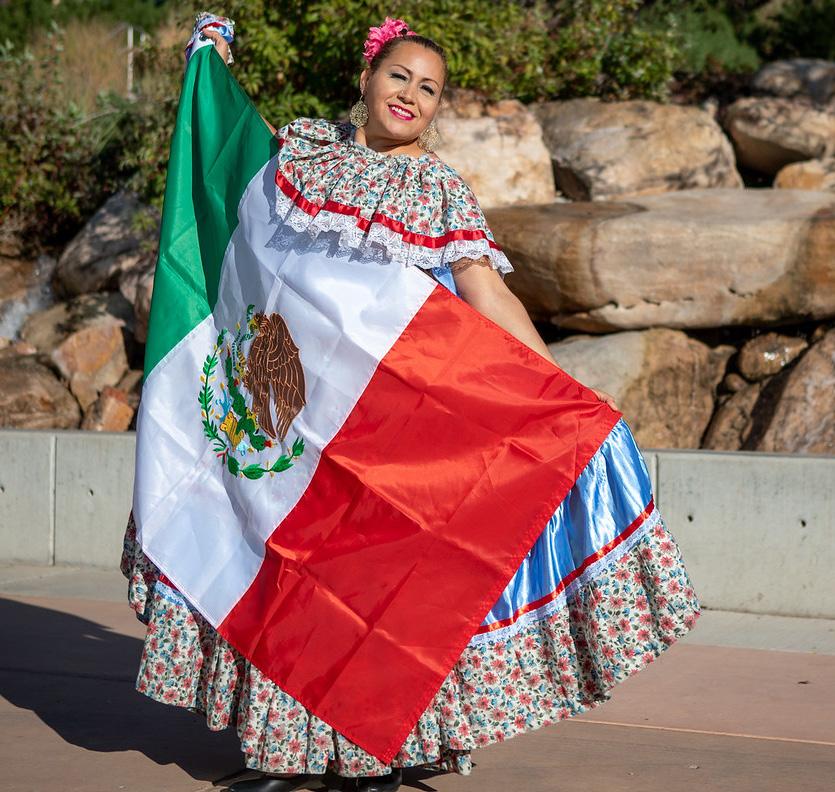

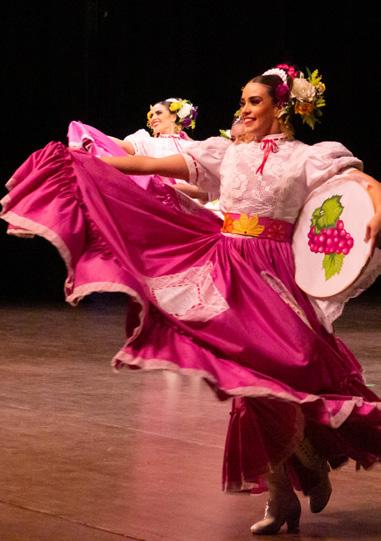
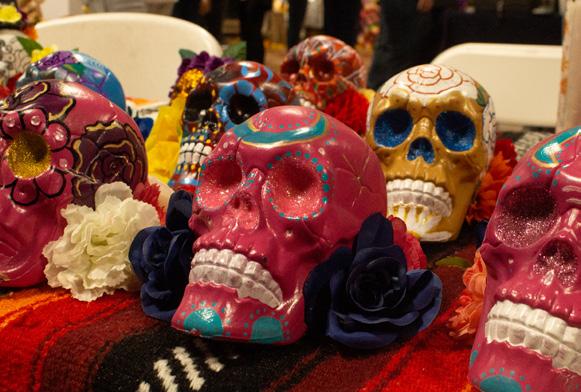


El mes de Herencia Hispano y Latino comienza cada año desde el 15 de septiembre hasta el 15 de octubre. Durante este mes celebramos la historia, cultura e impacto de la comunidad Hispano y Latino. Honramos a la cultura Hispano y Latino a través de la música, la comida, tradiciones, la lucha por los derechos civiles, nuestras diferencias entre diferentes países y mucho más. Aunque haiga un mes entero para nosotros no había escuchado tanto de esto hasta recientemente.
En realidad, no sé cómo sentirme sobre el mes de Herencia Hispano y Latino. No sabía que existía hasta estos últimos años. No nos enseñan tanto sobre la historia o los impactos de los Hispanos y Latinos si no es en relación a otros países. Una de las razones en que el mes de Herencia Hispano y Latino no comienza al principio de un mes es porque bastantes países de Centroamérica como Costa Rica, El Salvador, Guatemala, Honduras y Nicaragua celebran su día de independencia el 15 de septiembre. Tratamos de mantener viva nuestra cultura y cambiando y manteniendo cosas mientras el tiempo pasa y más gente se va de sus países de origen a buscar más oportunidades. He notado que muchas de las historias de otros inmigrantes Latinos y Hispanos son similares. Es tan común que nuestros padres lleguen a los Estados Unidos sin nada, comenzar de nuevo, trabajar hasta decir basta, sostener a su familia y tratar de formar nuevas conexiones en un país desconocido. Dejando casi todo con la esperanza de encontrar trabajos y oportunidades mejores para ellos mismos y sus hijos. Mis padres comparten una experiencia similar con otros inmigrantes.
Mi familia es de Perú, y mis padres estudiaron y obtuvieron sus títulos de maestría en Perú donde mi mamá estudió obstetricia y mi papá estudió justicia criminal. Mi mamá era una enfermera obstétrica y mi padre era abogado. A pesar de los esfuerzos de mis padres no podían encontrar trabajo y enci-

ma de todo eso el terrorismo que enfrentaron en esos tiempos influyó su decisión de inmigrar a los Estados Unidos. Mis padres llegaron a los Estados Unidos el 11 de enero de 2001. Desde allí decidieron mudarse a West Valley City, Utah. Allí yo y mis 4 hermanos nos criamos, formando nuestra comunidad y amistades en una ciudad con varias personas que también se parecían a mi.
Haber crecido en West Valley City es una
parte fundamental de mi, pero también es una parte fundamental del estado de Utah. West Valley City es una de las ciudades más diversas en población en el estado, con un porcentaje de 25,2 siendo Hispanos y Latinos; todos de diferentes países Hispanos y Latinos. Hay celebraciones para diferentes países Hispanos y Latinos, restaurantes, tiendas, bailes, conciertos, ceremonias religiosas y más.
Entre los peruanos tenemos el festival pe-
ruano, la misa del Señor de los Milagros y apoyamos diferentes lugares y personas que venden comida. El festival peruano es celebrado cada año en días cercanos al 28 de julio, el día de independencia de Perú. Nos reunimos a comer, bailar, platicar y comprar cachivaches. Algunos lugares de comer son El Rocoto, Casa Perú, Manos Morenas, El Rico Sanguchom D’chalo y más. Después de la misa del Señor de los Milagros procesamos, rezamos, nos bendicen y
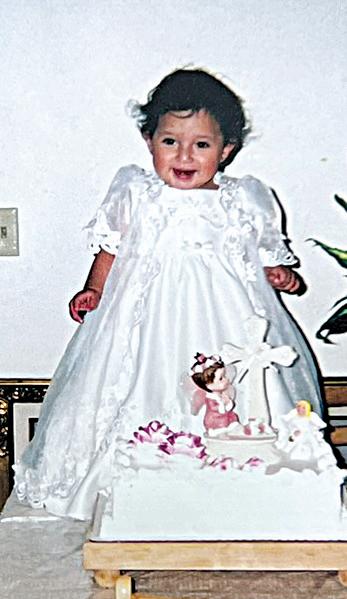
nos dan flores. Estos eventos moldearon mi niñez y se han hecho parte de mi ser. Cuando llegué a la universidad de Weber State quería ser parte de algo además de lo que estaba estudiando, que en ese tiempo era la astrofísica. El día de orientación cuando estaba viendo a los clubs y extracurriculares me di cuenta de una mesa que tenía algunos papeles, que resultaron ser periódicos. Allí encontré The Signpost, el periodico de la universidad hecho por los estudiantes, y me pareció algo interesante. Me gustaba escribir pero no tenía la confianza de ser reportera. Vi que tenían posiciones de traductores y me apliqué a ser una sin esperar a algo porque no esperaba ser aceptada, pero luego cuando me aceptaron a la posición me sentí dotada. A pesar que el español fue mi primer idioma, soy bilingüe y sabía cómo escribir un poco en español, se me hizo tan difícil traducir. Sin embargo después de un tiempo me di cuenta que tra-

IZQUIERDA: Nelly Hernandez a la edad de 2, después de su bautismo católico. ARRIBA A LA DERECHA: Nelly Hernandez y sus 4 hermanos en su segundo cumpleaños. ABAJO A LA DERECHA: Los padres de Nelly Hernandez, Victor Hernandez y Nelly Tejada.

ducir era algo que sí me hacía feliz, sentía que era la única cosa que me gustaba de la escuela. Terminé cambiando lo que estaba estudiando de astrofísica a traducción de español. Después de un poco de tiempo mejorando mi habilidad para traducir, apliqué a ser uno de los editores de traducción, y pude obtener la posición. En mi tiempo en The Signpost he podido crear amistades y conexiones profesionales. Apuntarme y partici-
par en The Signpost han tenido un impacto enorme en mi tiempo universitario. Ahora lo que el mes de Herencia Hispano y Latino significa para mi es tener perseverancia y orgullo en nuestras raíces. Mis padres, mi comunidad y los que vinieron antes que yo representan lo que significa ser Hispano y Latino. Estoy orgullosa de ser peruana, en mi identidad y mi camino.
Writing, photos and translation
by NELLY HERNANDEZ TEJADA Columnist
Translated by
NATHANAEL STOUT Editor
Hispanic Heritage Month starts every year on Sept. 15 and ends on Oct. 15. During this month, we celebrate the history, culture and impact of the Hispanic and Latino communities. We honor Hispanic and Latino culture through music, food, traditions, advocating for civil rights, educating on the differences between our ethnicities and more. Even though it’s an entire month dedicated to us, I hadn’t heard much about it until recently. In reality, I didn’t know how to feel about Hispanic Heritage Month. I didn’t know it existed until recent years. We’re not taught about the history or importance of Hispanics and Latinos unless it’s in relation to another country. One of the reasons why Hispanic and Latino Heritage Month isn’t celebrated at the beginning of the month is because multiple Central American countries such as Costa Rica, El Salvador, Guatemala, Honduras and Nicaragua celebrate their independence day on Sept. 15. We try to keep our culture alive through changing and keeping things the same over time as more people leave their home country to find better opportunities. I’ve noticed that many of the stories of Hispanic and Latino immigrants are similar. It’s very common for our parents to arrive in the United States with nothing, start over, work for hours on end, maintain their family and begin to form connections and relationships in an unfamiliar country, leaving everything behind in the hopes of finding jobs and better opportunities for themselves and their children. My parents share a story similar to other immigrants.
My family is Peruvian. My parents went to
school and got their master’s degrees in Peru where my mom studied Obstetrics and my dad studied Criminal Justice. My mom was an obstetric nurse and my dad was a lawyer.
Despite their efforts, my parents couldn’t find a job. Not only that, but the terrorism they were witnessing influenced their decision to immigrate to the United States.
My parents got to the United States on Jan. 11, 2001. From then on they decided to move to West Valley City, Utah. There, my four siblings and I were raised, building our own relationships and community in a city where there were people who looked like me.
Having grown up in West Valley City is a fundamental part of me, but it’s also a fundamental part of Utah. West Valley City is one of the most diverse cities in the entire state with 25.2% of its population being Hispanics and Latinos; all made up of different ethnicities. There are different events and celebrations for different Hispanic and Latino countries and ethnicities, restaurants, stores, dances, concerts, religious ceremonies and more.
Among Peruvians we have the Peruvian Festival, la misa del Señor de los Milagros (the Mass of the Lord of Miracles), and we also support different places and people that sell food. The Peruvian Festival is celebrated every year in the days around July 28, the Peruvian independence day. We get together to eat, dance, chat and share nicknacks.
A few places to eat include El Rocoto, Casa Perú, Manos Morenas, El Rico Sanguchom D’chalo and more. After la misa del Señor de los Milagros, we form a procession, pray and are blessed and given flowers. These events molded my child and have become a part of who I am.
When I arrived at Weber State University, I wanted to be a part of something besides what I was studying, which at the time was astrophysics. During orientation, when I was checking out clubs and extracurricular activities, I noticed a table that had some papers
on it which turned out to be newspapers. There I found The Signpost, the university newspaper made by students, and it seemed interesting.
I liked writing, but I didn’t have the confidence to be a reporter. I saw that they had positions for translators, so I applied to be one without expecting anything because I figured I wouldn’t be accepted, but later, when I got accepted, I felt accomplished. Despite Spanish being my first language, being bilingual and knowing how to write decently in Spanish, it was difficult for me to translate. After a time, however, I realized that translating was something that made me feel happy, and I felt like it was the only thing that I really liked about school. I ended up changing my major
from astrophysics to Spanish Translation.
After some time improving my ability to translate, I applied to be a Translation Editor, and was able to get the position. During my time at The Signpost, I have been able to form friendships and professional connections. Signing up and participating at The Signpost has had an enormous impact on me in my time at college.
Now, what Latin and Hispanic Heritage month means to me is having perseverance and pride in our roots. My parents, my community and those that came before me represent what it means to be Hispanic and Latino. I am proud to be Peruvian, both in my identity and in my path in life.

weber.edu/student-access-success/student-fees.html


Assistant Editor
Sept. 21, the 22nd annual Harvest Moon Celebration brought the Ogden community together for a full day of fall festivities on Historic 25th Street from 10 a.m. to 9 p.m. Hosted by the Ogden Downtown Alliance; the celebration consisted of family-friendly games, live entertainment from musicians and cultural groups and local vendors selling food and apparel or accessories. It solidified its role as Northern Utah’s most anticipated — and free — annual event. It was a showcase of cultural heritage and artistic identity as the seasons change.
The day started with the NuHope Suicide Awareness Walk at the Ogden Amphitheater, hosted by McKay-Dee Hospital. This year’s festival included extended hours, a produce market, a beer garden of local brews for adults and artistic displays like pumpkins, tractors and curated photo stand-ins. Street performers included stilt walkers and a roaming magician.
Attendees participated in popular attractions, including an axe-throwing competition and a climbing wall. Kids, especially, had opportunities to create plaster fossil casting, wooden moon phases art and pumpkin crafts.
The Harvest Moon Celebration strengthens connections and the local economy by promoting local businesses, artists and organizations, bringing around an increasing 30,000 guests.
View more photos for this story at thesignpostwsu.com!

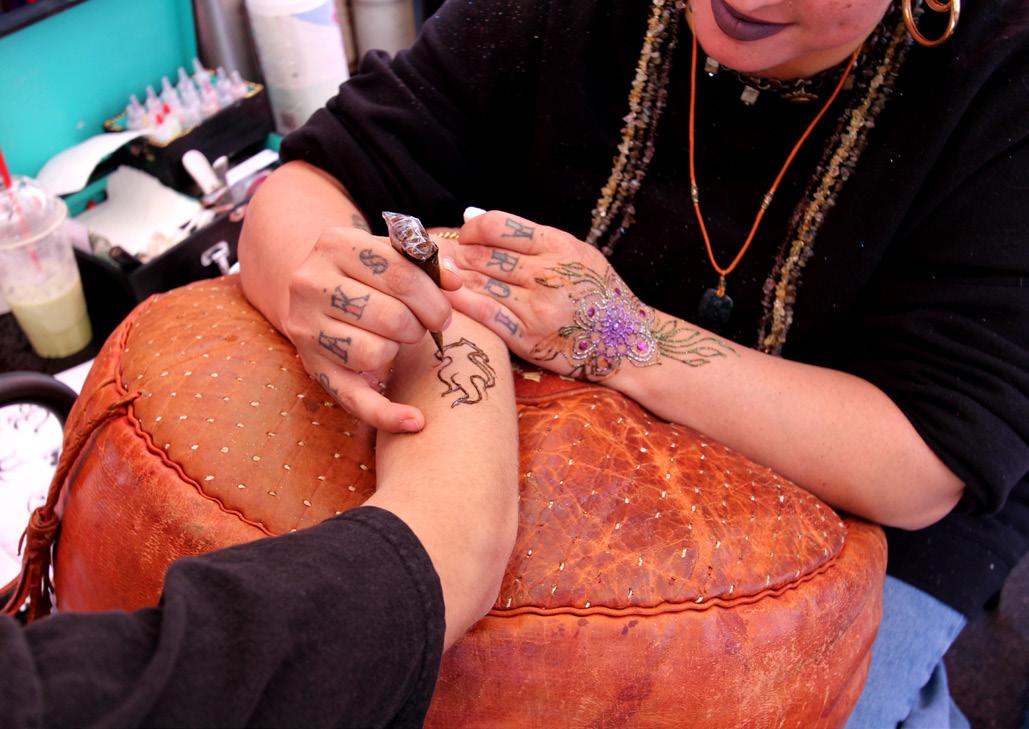

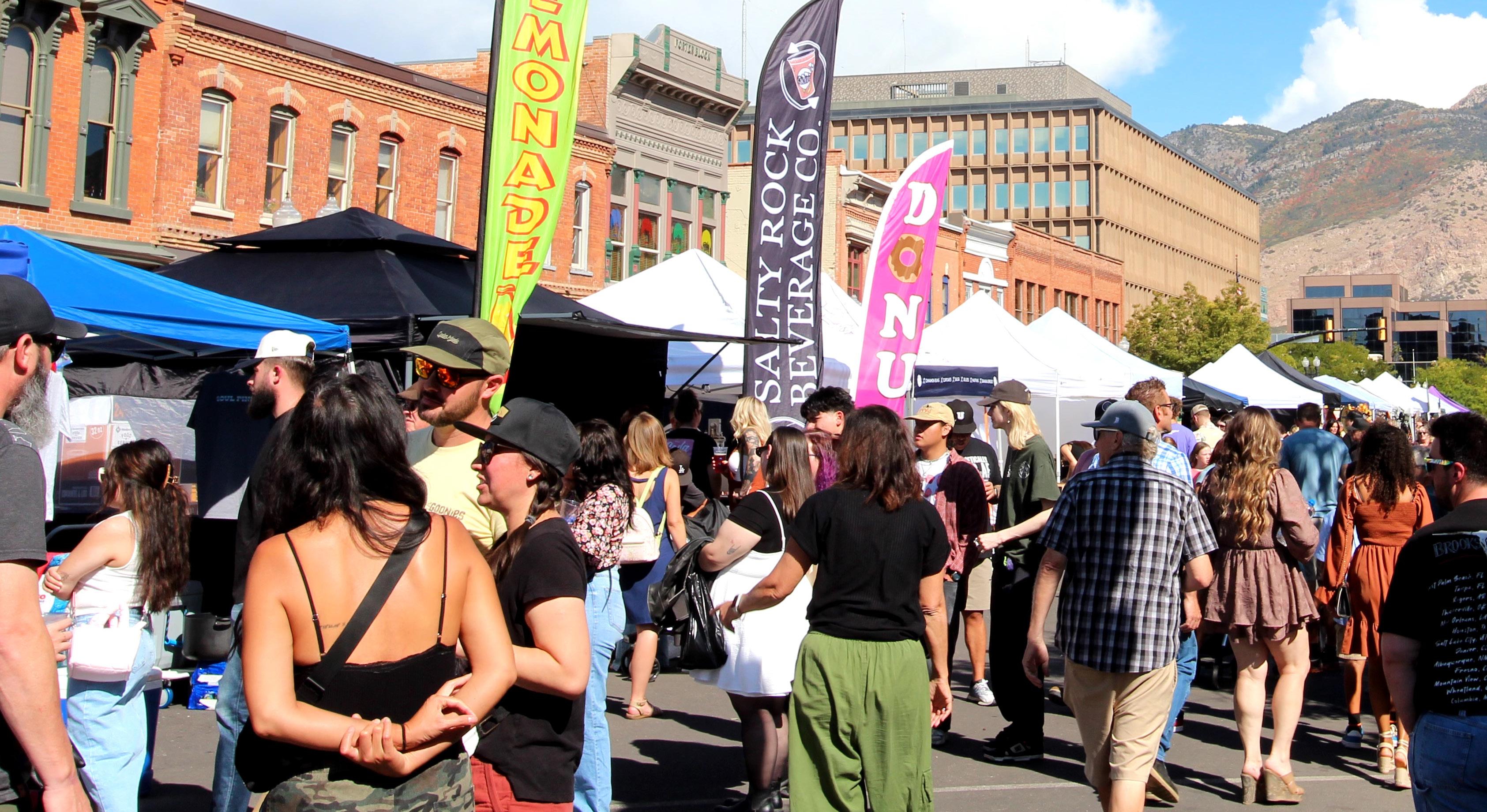

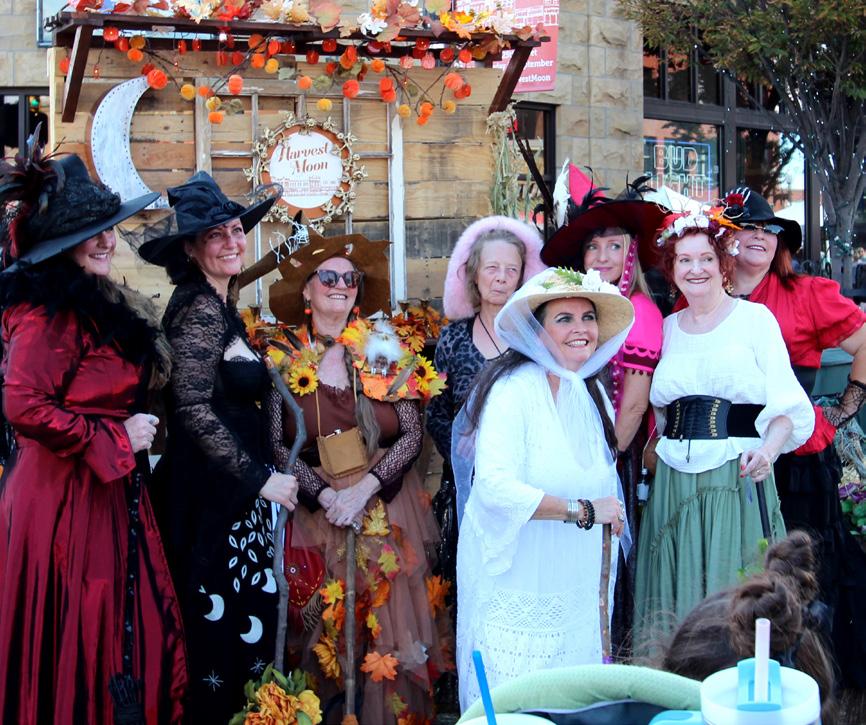


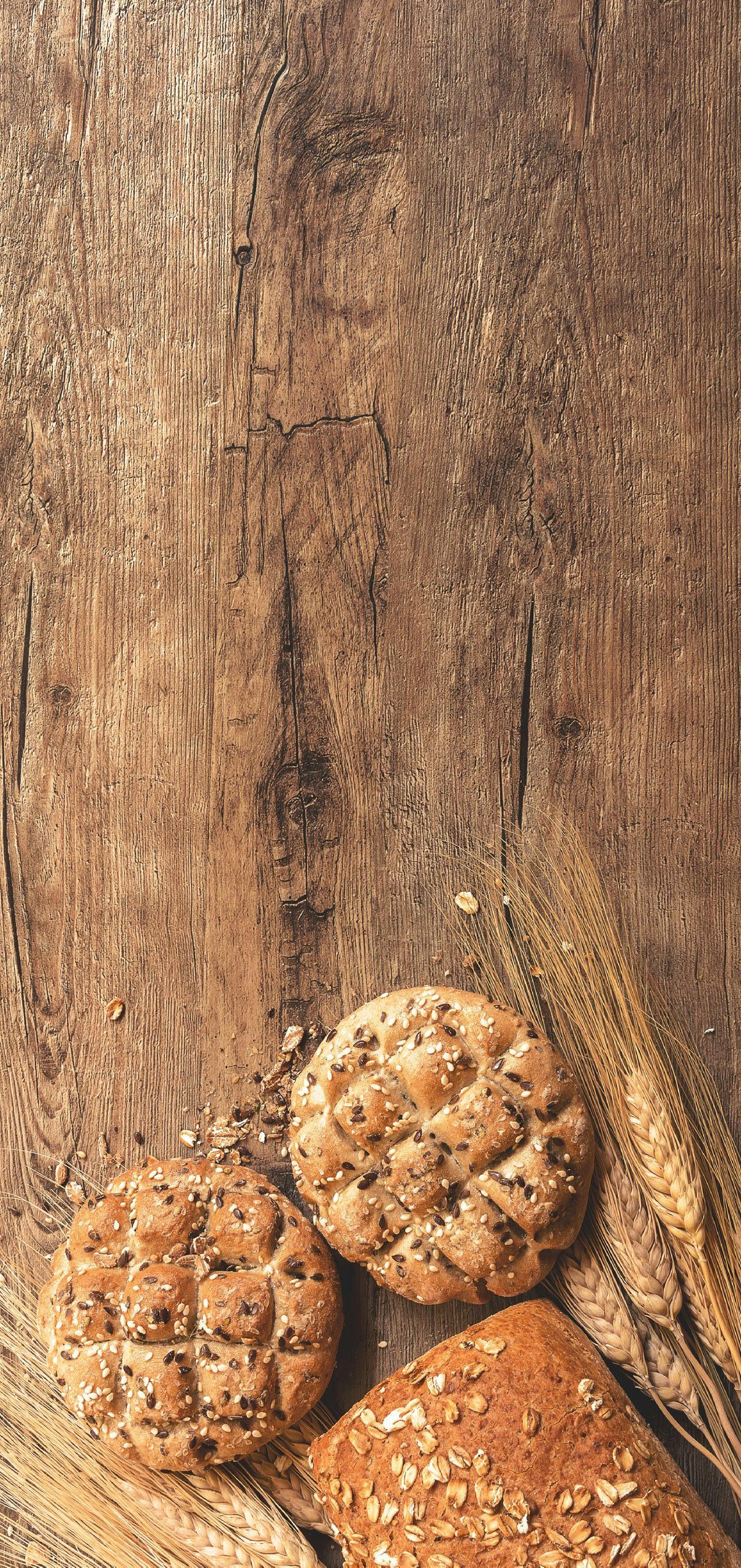


By TENAYA HYDE Reporter
Sept. 15 to Oct. 15 is Hispanic Heritage Month, and Weber State University opened its celebrations on Sept. 17 by inviting some of Utah’s luminaries to speak at the Leading for Impact event in the Shepard Union Wildcat Theater. Students gathered to hear multicultural experts Yudi Lewis, Nubia Peña and want to do the same for anyone anywhere,” Lewis said.

The importance of education was a primary theme among the speakers as they addressed questions submitted by students before opening the discussion to a full Q&A. Lewis, a first-generation college attendee, told a story of her grandmother. With a third-grade education, Lewis’s grandmother created “A school without walls,” where she taught classes up to the third grade.
“We cannot solve all the world’s problems; we can have an impact on a small
Nubia Peña, senior advisor on Equity and Opportunity and director of the Utah Division of Multicultural Affairs, also comes
from an education-minded family. Her own grandmother was an educator despite only receiving a fifth-grade education.
“Education is a gateway for your life trajectory to change,” Peña said.
Peña watched her mother work with disabled people and learned from how her mother showed respect and dignity toward everyone.
“Dignity is inherent in everyone,” Peña said.
Laís Martinez, assistant commissioner for Belonging and Opportunity for the Utah System of Higher Education and once a non-traditional student, understands firsthand the challenges that students face. Martinez has been firm in her commitment to aid and
assist those who might otherwise might not have this opportunity.
“I know the power of education,” Martinez said.
Martinez sees education as a sacred and liberating power. She has worked with leaders in government, business, higher education, and statewide communities to close the disparity between underrepresented and privileged communities, in efforts to bring greater equality to the state.
Upcoming events to celebrate Hispanic Heritage Month at Weber State include a keynote address, a Spanish slam poetry contest, and a Latin art exhibit throughout October.





Por NATHANAEL STOUT Traductor
Por DELANEY HARRISON Reportero
Building Puentes (la construcción de puentes), un programa diseñado para beneficiar a latinos y hispánicos que aprenden en la universidad Weber State, recibió una subvención de $2.5 millones. Este programa se abrió este semestre de otoño con la esperanza de aumentar el número de graduados que están listos para una carrera en una profesión bilingüe.
El programa provee credenciales apilables que cuenta para las carreras de estudiantes. Por medio de clases enseñadas completamente en español, los estudiantes pueden ganar un certificado para su carrera. El certificado ofrecido por el programa puede usarse para un diplomado, el cual puede aplicarse a una licenciatura.
Aunque Building Puentes actualmente tiene clases de espíritu emprendedor, los directores quieren expandirse en más áreas de estudio como la ciencia de salud y la ciberseguridad.
Bryan Magaña, director de relación pública en Weber State, está emocionado por
este nuevo programa y lo potencial que trae al campus.
“El programa tuvo su lanzamiento suave este semestre y crecerá durante los próximos cinco años”, dijo Magaña.
Mientras que Magaña tiene esperanza para este programa, Building Puentes potencialmente podría encontrar problemas con el proyecto de ley 261, el cual restringe las iniciativas de diversidad, equidad, e inclusión que entró en vigencia este verano. Si Building Puentes tiene que seguir las normas establecidas en el proyecto, la financiación se puede quitar, lo que resultará en la falta de millones de dólares para We-
ber State.
La subvención de $2.5 millones es condicional con su desarrollo y refinamiento a largo plazo. Si el programa no alcanza su meta de admisión durante un periodo de cinco años, el programa se considerará un fallo, y la financiación se quitará.
Como una institución que sirve a los hispánicos, la universidad Weber State continúa en el trabajo de llevar la financiación y nuevos recursos a los estudiantes con necesidades. Los estudiantes que quieran aprender más o aplicar para Building Puentes pueden visitar la página web del programa en el sitio web de Weber State.
By DELANEY HARRISON Reporter
Building Puentes, a program designed to benefit Latino and Hispanic learning at Weber State University, has been given a $2.5 million grant. This program launched this fall semester in hopes to increase graduates that are career-ready in bilingual professions.
The program provides stackable credentials that count toward students’ degrees. Through classes taught completely in
Spanish, students can earn a certificate for their degree. The certificate offered by the program can be used towards an associate degree, which can then be applied towards a bachelor’s degree.
Though Building Puentes currently hosts entrepreneurship classes, its directors would like to branch out into more areas of study such as health sciences and cybersecurity.
Bryan Magaña, Public Relations director at Weber State, is excited for this new program and the potential that it brings to
campus.
“The program soft-launched this semester and will be growing over the next five years,” Magaña said.
While Magaña is hopeful for this program, Building Puentes could potentially run into issues with House Bill 261, a bill restricting diversity, equity, and inclusion initiatives that went into effect this summer. If Building Puentes has to follow the guidelines established in HB261, funding could be pulled, resulting in the loss of millions of dollars to Weber State.

The $2.5 million grant is conditional on its long-term development and refinement. If the program does not reach its admissions goal in five years, the program will be considered a failure, and funding will be pulled.
As a Hispanic serving institution, Weber State University continues to work on bringing funding and new resources to students in need. Students looking to learn more or apply for Building Puentes can visit the program’s page on Weber State’s website.

Por NATHANAEL STOUT Traductor
Por WIKTORIA KOLODZIEJCZYK Reportero
Una nueva organización, el club de investigaciones de escenas del crimen, recientemente se abrió en la universidad Weber State este semestre de otoño.
Kira McLelland, un estudiante y la presidente del club, dijo que miembros del departamento de la justicia criminal en WSU han organizado eventos extraoficiales incluyendo viajes a partidos de hockey y barbacoas en el pasado.
Después de algunas reuniones en agosto para la discusión de los pasos necesarios para la formación oficial de un club y el contacto con estudiantes interesados, la iniciativa de establecerse como un club reconocido fue establecida.
Aunque el club acaba de abrirse, ya ha fijado el horario semanal, una visión clara y metas para el futuro. Las reuniones tienen lugar cada viernes a las dos en Lindquist Hall.
Su objetivo es trabajar en una tarea específica de investigación
o salir y hacer una actividad que fomente la interacción social entre los miembros. El propósito de las reuniones no solo es compartir el interés en el campo de la justicia criminal sino también enriquecer el conocimiento y entendimiento de los miembros sobre el proceso real de la investigación de escenas del crimen.
“Queremos proveer algunas oportunidades únicas que no existen en la clase”, dijo McLelland. El club tiene muchos objetivos, uno de los cuales es combatir las misconcepciones sobre el campo de la ciencia forense que tienen raíz en lo que es llamado el “efecto de CSI”.
“En el campo hablamos mucho sobre el efecto de CSI, hay muchas series del crimen en el mundo, y muchos creen que la investigación de escenas del crimen es como esas series … entonces nuestra meta primera es explicar cómo funciona en realidad y correr la voz”. dijo McLelland.
Para lograr estos planes, los miembros del club planean organizar talleres con oradores invitados y hacer proyectos que los dejen aprender más sobre la
fotografía, cómo tomar huellas digitales y otras habilidades esenciales para el campo.
Los miembros del club buscan opciones de aprendizaje, y una de ellas es involucrarse en proyectos comunitarios que se enfoquen en la escuela secundaria. Una idea para un proyecto incluye usar escáneres para crear planos de edificios de escuela que después se compartirán con equipos locales de SWAT. Esta operación contribuiría con mejorar la respuesta a emergencias durante los incidentes. Otro plan es hacer operaciones de coleccionar las huellas digitales en escuelas primarias locales para proveer un paquete de identificación fiable que se comparta con los padres de estudiantes en caso de una emergencia.
El club de investigación de escenas del crimen de WSU continua creciendo por medio de boletines semanales enviados cada miércoles y la expansión de su presencia en línea a través de su cuenta de Instagram @csi_wsu1.

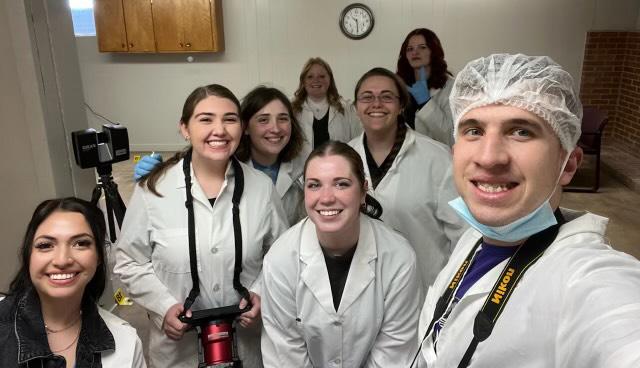
By WIKTORIA KOLODZIEJCZYK Reportero
A new student organization, the Crime Scene Investigation Club, recently launched at Weber State University this fall semester.
Kira McLelland, a Weber State University student and club president, said members of the Criminal Justice Department at WSU have been organizing unofficial events including outings to hockey games and barbecues in the past.
Following a few meetings in August to discuss the necessary steps for official club formation and reaching out to the interested students, the initiative of having these gatherings established as a recognized club was set.
Although the club has just launched, it has already established weekly meeting times, a clear vision and goals for the future. The meetings take place every Friday at 2 p.m. in Lindquist Hall.
Their objective is to work on a specific crime scene investigation task or to go out and do an activity that would foster social interaction among members. The purpose of the gatherings is not only to share interest in the criminal justice field but also enrich members’ knowledge and understanding of the real world crime scene investigation processes.
“We want to provide some unique opportunities that we do not have in classes,” McLelland said.
The club has many missions, one of which
is to combat misconceptions about the forensic science field, stemming from the socalled “CSI effect”.
“In the field we talked a lot about the CSI effect, there are a lot of crime shows out there, and a lot of people think that the crime scene investigation is like in those popular TV shows … so our main goal is to explain how it really works in the real world and to spread the word out,” McLelland said.
To accomplish these plans, the club members are planning on organizing workshops with guest speakers and doing operations that would allow them to learn more about photography, fingerprinting and other essential skills to the field.
Club members are looking into learning options, and one of them is getting involved
in community projects that would focus on high schools and junior highs. One idea for a project includes using 3D scanners to create blueprints of school buildings that later would be shared with local SWAT teams. This operation would contribute to enhancing emergency response during incidents. Another plan is to conduct fingerprinting operations at local elementary schools to provide a reliable identification package that would be shared with students’ parents to use in case of any emergency.
The WSU Crime Scene Investigation Club continues to grow through weekly newsletter sent out every Wednesday and by expanding its online presence through their Instagram account @csi_wsu1.
POR VICTORIA HERNANDEZ
Traductor
POR GAVIN NELSON
Reportero
Una semana después de perder a Lamar University 17-16, El equipo de football de Universidad de Weber State se recuperó contra otro equipo de la Conferencia Southland, ya que derrotó a los Demonios de la Universidad Estatal Northwestern 39-0.
El partido casi empezó mal para los Wildcats, ya que el receptor de los Demons, Myles Kitt-Denton, devolvió el saque inicial 91 yardas para conseguir un touchdown. Afortunadamente para Weber State, fue anulado después de que uno de los Demons cometiera una penalización de holding.
Los Demonios fueron detenidos en los dos primeros downs, pero en la 3ra y 1, el safety de los Wildcats, Trevian Tribble, le quitó el balón de las manos al quarterback de NW State, dando el balón a los Wildcats.
Después de un tres y fuera, WSU envió a la unidad de gol de campo dirigido por el pateador senior Kyle Thompson. Sin embargo, la primera patada de Thompson falló, manteniendo el marcador en 0-0.
Tras de algunas paradas consecutivas por parte de ambos equipos, el quarterback de Weber State Richie Muñoz encontró al receptor de los Demons Noah Kjar, quien llevó el balón hasta la yarda uno. Sin embargo, después de una pérdida de dos yardas en una carrera de Damon Bankston, un pase incompleto de Muñoz y un saco de Northwestern, los Wildcats optaron por patear un gol de campo en el cuarto down. Thompson hizo el gol de campo de 29 yardas.
Tras otra parada de la defensa, los Wildcats se apoderaron del balón en la yarda 50. Muñoz le dio al receptor de los Demon Jacob Sharp un pase de touchdown de 35 yardas, después de una ejecución de 15 yardas de Bankston.
Cuando los Wildcats lanzaron el punto extra, había un pateador diferente liderando la formación. El pateador junior Sloan Calder sustituyó a Thompson para el resto de la
noche. Calder, que había estado lidiando con una lesión de cadera en el pasado, había sido utilizado principalmente como el especialista en kickoff del equipo, pero hoy fue el pateador del equipo.
Después de que la defensa forzara otro tres y fuera de los Demon, Muñoz encontró de nuevo a Sharp para un touchdown de 38 yardas. Sin embargo, Sharp hizo un pequeño baile al entrar en la zona de anotación, lo que provocó que el árbitro lanzara una bandera por conducta antideportiva, que anuló el touchdown. Afortunadamente para los Wildcats, Bankston corrió en un touchdown de siete yardas para aumentar la ventaja Wildcat a 17.
El partido continuó con más juego de dominio de la defensa de la WSU, un gol de campo de Calder y un pase de touchdown de Muñoz al receptor de los Demon Jaden Thrower. Terminando la primera mitad con una ventaja de 27-0.
En el primer drive de los Wildcats de la segunda mitad, Muñoz lanzó un pase de touchdown de 33 yardas al receptor de los Demon Jayleen Record para poner el partido 34-0.
La defensa respondió con un placaje a la defensa. La defensa respondió entonces con un saque al quarterback de los Demon en su propia zona de anotación, provocando un safety de dos puntos.
Después de otro gol de campo en el último cuarto, el partido terminó con una victoria de 39-0 para los Wildcats.
Muñoz terminó el partido con 327 yardas y tres touchdowns, Bankston lideró al equipo en carrera con 56 yardas y un touchdown y Sharp lideró en recepción con 119 yardas y un touchdown. La defensa fue liderada por el ala defensiva Kemari Munier-Bailey, una transferida de California State University, Fresno, que tuvo ocho tackles, seis tackles por pérdida y tres sacks.
Los Wildcats vuelven a casa esta semana para enfrentarse a su tercer y último rival de la conferencia Southland, los Cowboys de McNeese State University. El partido será el sábado 28 de septiembre a las 6 p.m. en el Stewart Stadium.

By GAVIN NELSON Reporter
One week after losing to Lamar University 17–16, the Weber State University football team bounced back against another Southland Conference team, as they defeated the Northwestern State University Demons 39–0.
The game almost started poorly for the
Wildcats, as the Demon’s wide receiver Myles Kitt-Denton returned the opening kickoff 91 yards for a touchdown. Fortunately for Weber State, it was called back after a holding penalty was committed by one of the Demon’s players.
The Demons were stopped on the first two downs, but on 3rd and 1, Wildcat safety Trevian Tribble stripped the ball out of NW State’s quarterback’s grasp, giving the Wild-
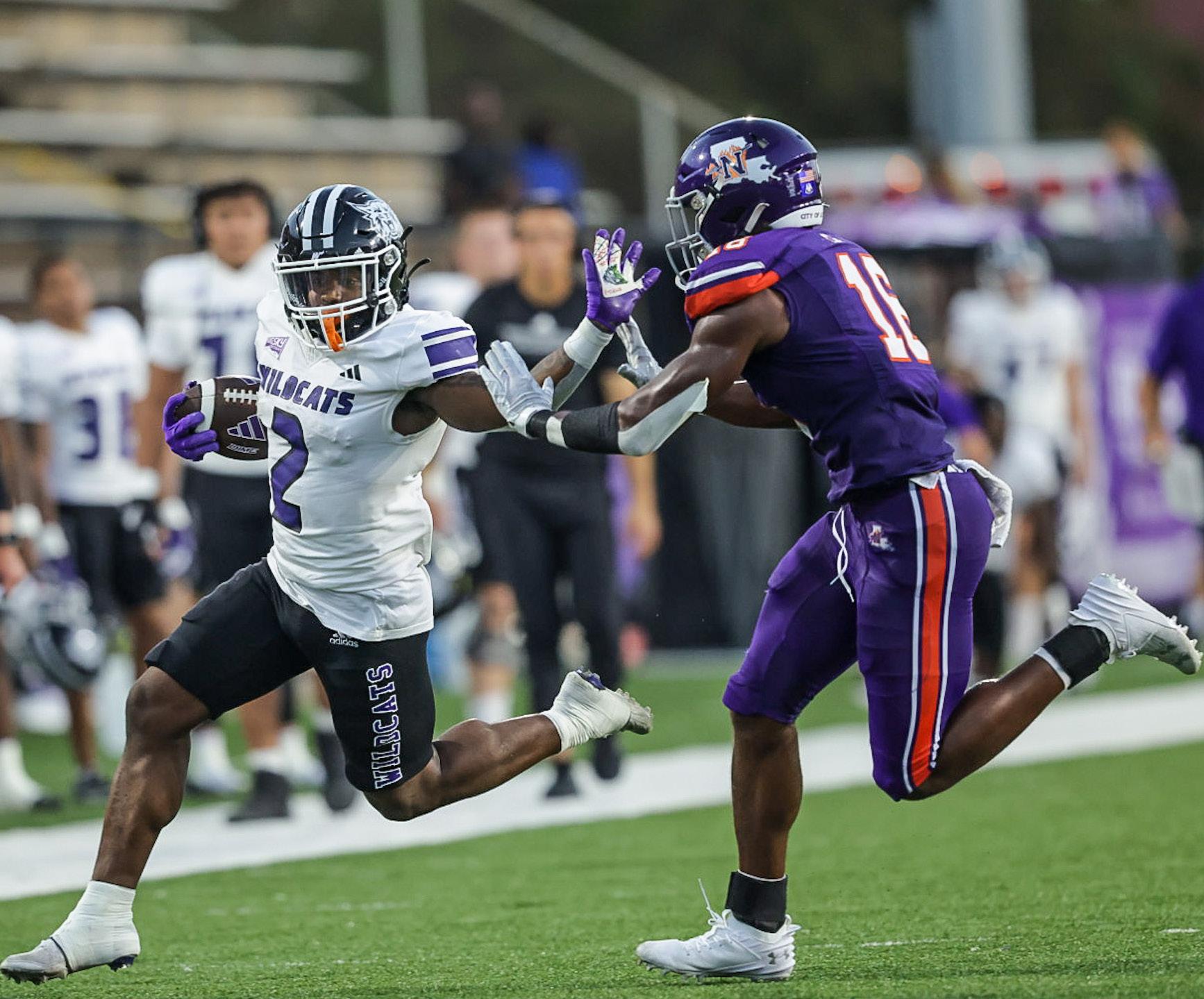



cats the ball.
After a three-and-out, WSU sent out the field goal unit led by senior kicker Kyle Thompson. However, Thompson’s first kick missed, keeping the score at 0–0.
After some back-to-back stops by both teams, Weber State quarterback Richie Munoz found freshman wide receiver Noah Kjar who got the ball down to the one-yard line. However, after a two-yard loss on a run from Damon Bankston, an incomplete pass from Munoz and a sack from Northwestern, the Wildcats elected to kick a field goal on 4th down. Thompson made the 29-yard field goal.
After another stop by the defense, the Wildcats got the ball at the 50-yard line. Munoz hit senior wide receiver Jacob Sharp in stride for a 35-yard touchdown pass after a 15-yard run from Bankston.
As the Wildcats sent out the extra point team, there was a different kicker leading the unit. Junior kicker Sloan Calder replaced Thompson for the rest of the night. Calder, who had been dealing with a hip injury in the past, had mostly been used as the team’s kickoff specialist but was used as the team’s placekicker today.
After the defense forced another Demon three-and-out, Munoz found Sharp again for a 38-yard touchdown. However, Sharp did a little dance as he went into the endzone causing the referee to throw a flag for unsportsmanlike conduct, which nullified the touchdown. Fortunately for the Wildcats,
Bankston ran in a seven-yard touchdown to increase the Wildcat lead to 17.
The game continued with more dominant play from the WSU defense, a field goal from Calder and a touchdown pass from Munoz to sophomore wide receiver Jaden Thrower, ending the first half with a commanding 27–0 lead.
In the Wildcat’s first drive of the second half, Munoz threw a 33-yard touchdown pass to junior wide receiver Jayleen Record to make the game 34–0. The defense then responded by sacking the Demon’s quarterback in their own endzone, resulting in a two-point safety.
After another field goal in the fourth quarter, the game ended with a 39–0 win for the Wildcats.
Munoz finished the game with 327 yards and three touchdowns passing, Bankston led the team in rushing with 56 yards and one touchdown and Sharp led in receiving with 119 yards and one touchdown. The defense was led by defensive end Kemari Munier-Bailey, a transfer from California State University, Fresno, who had eight tackles, six tackles for loss and three sacks.
The Wildcats are back at home this week to take on their third and final Southland conference opponent, the McNeese State University Cowboys. The game will be on Sept. 28 at 6 p.m. at Stewart Stadium.








By BRAYSON BROWN Reporter
Weber State University’s women’s volleyball team welcomed the Brigham Young University Cougars to Swenson Gym for an in-state showdown on Sept. 20 and lost 3–0. The last time these two teams faced off was last year in the first round of the NCAA women’s volleyball tournament when BYU beat Weber 3–0 in a best-of-five match.
Set one was a back-and-forth battle, with BYU taking a 4–1 lead. Weber then answered back with a 3–0 run of their own to tie it up and then take their first lead at 6–5. The Wildcats then rode that momentum to achieve an 11–9 lead, prompting the Cougars to call a timeout.
BYU head coach Heather Olmstead rallied her troops during the timeout to motivate them to bring the game back. Weber then scored two more points to put the lead at 13–9, but the Cougars rallied and took set
one 25–20.
Set two had the same story as both teams gave their all and went back and forth. The Wildcats caught the Cougars off guard with their ability to serve. Weber won the aces category 3–2.
“We knew that we could serve tough, and we did,” head coach Jeremiah Larsen said.
Set three was where the Cougars’ No. 19 ranking was shown. BYU dominated the third set with outside hitter Elli Mortensen’s 15 kills on the day and Claire Little’s 10. BYU won set three 25–18 and obtained the sweep on the Wildcats.
“Northern Colorado is at the top in our league right now, and they are out there beating teams like this every single night, so we are going to have to play teams like this, so it’s a good experience for our kids, and hopefully we can learn something from it.” Larsen said.
The Cougars led in kills 49–27, assists 48–26, and blocks 9–4. The Wildcats’ record got
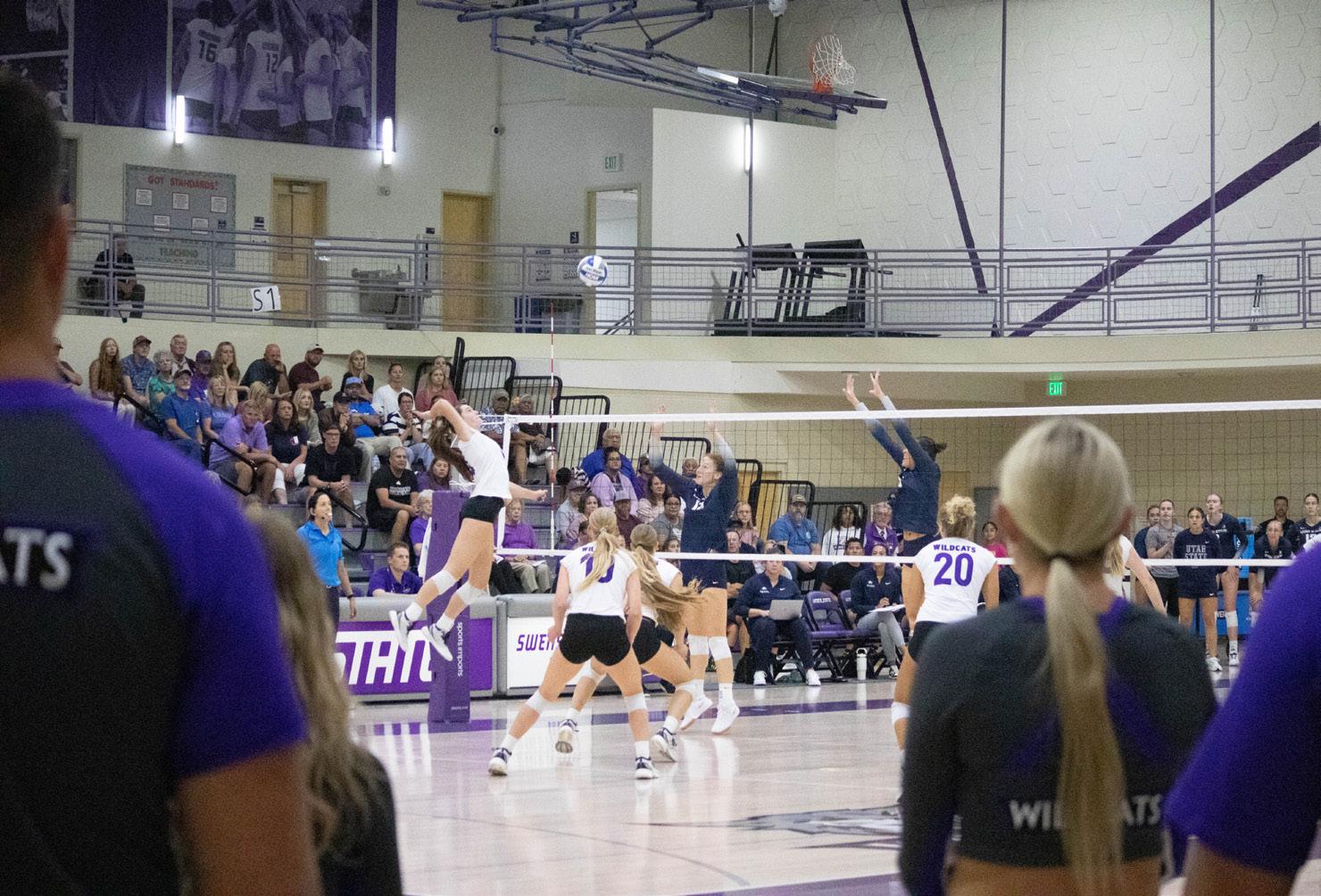
pushed to 3–7 on the year.
The Wildcats then took on the Utah State University Aggies in a five-set thriller, losing 3–2 on Sept. 21.
Weber managed to take sets one and two with the help of Ashley Gneiting, who had 19 kills.
“Having the confidence that my teammates are there for me and being able to rely on them and go have fun out there, I think we played together as a team for the most part, so it was fun,” Gneiting said.
The Aggies rallied back after having one foot over the edge of defeat and won the next three sets to crush the Wildcats’ hopes.
The Wildcats are now 3–8 on the year and will face Northern Arizona University on Sept. 25 in Flagstaff, Arizona. The women’s volleyball team will return to the Swenson Gym on Sept. 28 for a Big Sky Conference game against the University of Idaho.
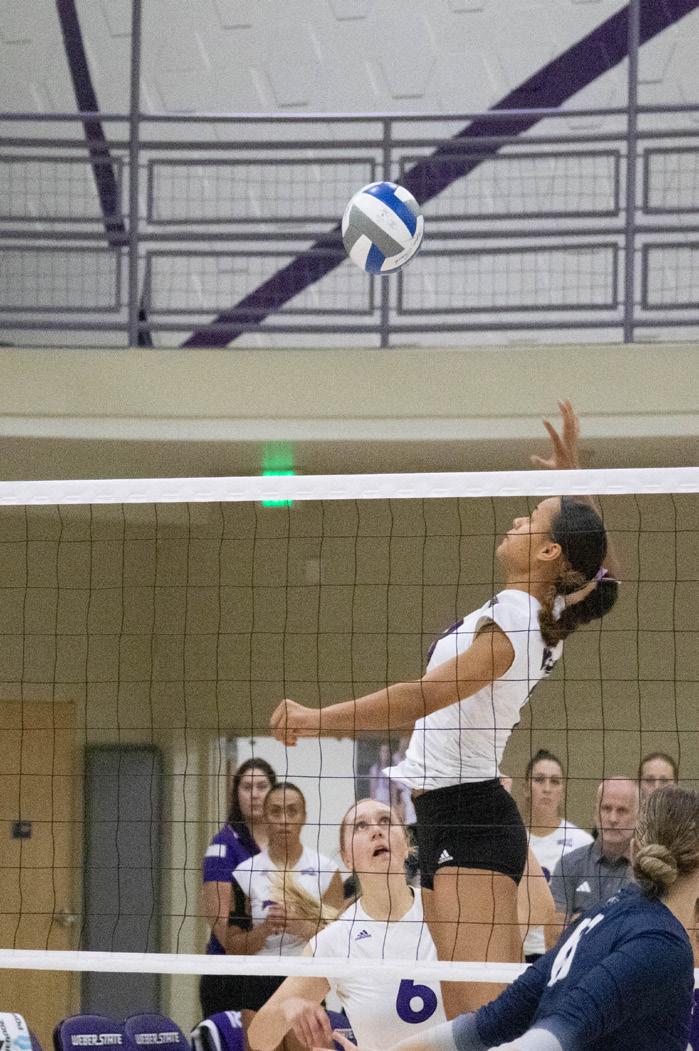
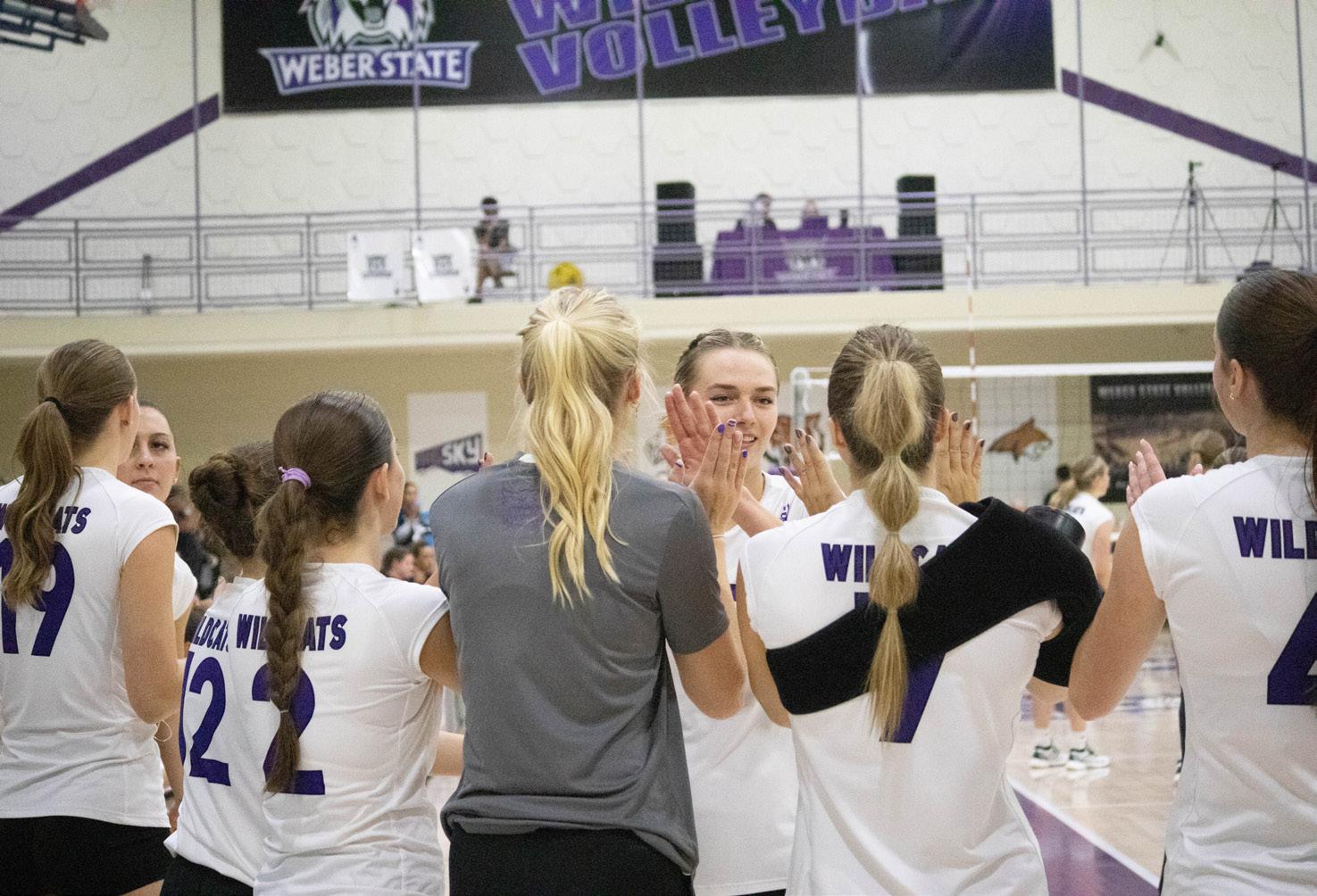
12 pm • Brown Bag Faculty Art Talk
12:30 pm – 1:30 pm
• What it Takes to be a Leader! An Interesting Story of Legacy and Advocacy
4 pm – 6pm • Crack your boots with WSU Balete Folklorico!
5 pm – 8 pm • Intramural Crate Stacking
7:30 pm • It Takes Two: The Art of Collaboration in Art Song
6 pm • Softball at Utah Valley
11 am – 1 pm • FAFSA Drop-in Help
4 pm – 6 pm • Crack your Boots with WSU Ballet Folklorico!
5 pm – 6 pm • Restore Yoga and Sound Bath
6:30 pm • Woman’s Volleyball at Northern Arizona
1 pm – 3 pm • Bowling and Pizza
5 pm – 8 pm • Intramural Crate Stacking
7 pm • WSU Soccer vs. Northern Colorado • Fall Canyoneering
Editor-in-Chief
Brisa Odenthal brisaodenthal@mail.weber.edu
Managing Editor
Emilie Hart emiliehart@mail.weber.edu
Design & Graphics Editor
Star Neil starneil@mail.weber.edu
Asst. Design & Graphics Editor
Alyssa Nelson alyssanelson2@mail.weber.edu
Asst. Copy Chief Mindy Brown mindybrown1@mail.weber.edu
News Editor Gracie Stephenson graciestephenson@mail.weber.edu
Sports Editor Collyn Cowles collyncowles@mail.weber.edu
Asst. Sports Editor Brayson Brown braysonbrown@mail.weber.edu
Photo Editor Anna Kuglar briannakuglar@mail.weber.edu
Chief Copy Editor Justin Steed justinsteed@mail.weber.edu
Culture Editor Megan Swann meganswann@mail.weber.edu
Asst. Culture Editor Cooper Hatsis cooperhatsis@mail.weber.edu
5 pm – 8 pm • Men’s Cross Country at Gans Creek Invitational • Fall Canyoneering
Translation Editor Nathanael Stout nathanaelstout@mail.weber.edu
Translation Editor Nelly Hernandez Tejada nhernandeztejada@mail.weber.edu
Adviser Deann Carver deanncarver@weber.edu
Business Manager Rob Steedley robertsteedley@weber.edu Tuesday Wednesday Thursday Friday Saturday
• Men’s Tennis at ITA Bedford Cup in the Mountains
10 am • Woman’s Tennis at Jon Messick Invitational
9 am – 12 pm • 2024 Walk to End Alzheimer’s- Weber/Davis, UT
12 pm – 4 pm • Mario Kart Tournament
1 pm • Softball at BYU
2 pm • Weber State Family Day
The Signpost is a student publication, written, edited and drafted by Weber State University students. Student fees fund the printing of this publication. Opinions or positions voiced are not necessarily endorsed by the university. The Signpost reserves the right to edit for reasons of space and libel and to refuse to print any letters. Letters should be submitted online to thesignpost@weber. edu and read letter to the Editor in the subject box. Letters should not exceed 350 words.
